![]()
![]()
![]()
Use LEFT and RIGHT arrow keys to navigate between flashcards;
Use UP and DOWN arrow keys to flip the card;
H to show hint;
A reads text to speech;
4 Cards in this Set
- Front
- Back
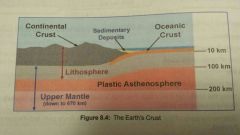
Structure and Layers of the Earth; CRUST:
|
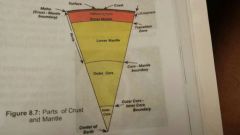
Crust - the outermost and the thinnest layer of the earth's lithosphere. Living things are also found here. It is also divided into two parts;
Continental crust - • mostly composed of rocks called granite and diorite. • 30 - 50 km thick. • this part of the crust is composed chiefly of silicon and aluminum combined with other elements. • composed of metamorphic and sedimentary rocks. • relatively light and brittle. • earthquakes occur within this layer. •[EVELATIONS] mountains, plateaus, and hills. (Mt. Everest, the highest evelation on 🌍 is about 9.5 kilometers or 9,500 meters above sea level) •[DEPRESSIONS] valleys, canyons, and plains. Oceanic crust - • that is mostly composed of basalt. • thinner than the continental crust. • the average thickness is 7.5 to 10 km. oceanic crust consists of dark, dense igneous rocks, such as basalt and gabbro. • seas and oceons cover this crust. •[DEPRESSION] is called trench; long, narrow valley on the seafloor— trenches form where ocean plate subduct or slip beneath the continental plates. The lowest point on Earth is the Marianas Trench in the Pacific Ocean; 11 km below sea level. The elevated part of the ocean floor is called ridge. Mid-oceanic ridges are areas in the oceanic floor formed feom volcanic eruptions along the fissures or crack in the ocean floor. These ridges are massive chains of mountains circling the ocean floor. Great seismic activities cut across the earth's mid-oceanic ridges. Beneath this crust is a boundary that separates the crust from the underlying mantle. This boundary is called Mohorovicic discontinuity or simply Moho. The crust is about 25 miles thick beneath the oceans. |
|
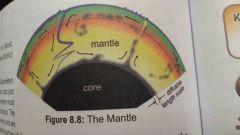
The Mantle:
|
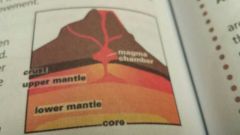
Mantle - is the thickest layer. It is about 5,200 kilometers thick and divided into two distinct layers: the upper and lower mantles;
Upper mantle - • is about 2,900 km and is a solid layer where most of the internal heat of the earth is located. • The crust and the upper mantle are rigid layers and are considered part of the lithosphere (solid portion of the earth). • About 6,500 km from the surface of the upper mantle is a molten but rigid layer called asthenosphere. It is believed that the molten rocks in the asthenosphere flow slowly like jot tar ad it is driven by convection currents. Such as convection currents, according to geologists, cause the movement. Lower mantle - • is about 2,500 km thick. Even though the temperature is higher here, this part of the mantle is solid. Tremendous pressure keeps the rocks from melting. • the lower mantle flows slowly at a rate of a few centimeters per year. • the lower mantle is composed mainly of iron and magnesium. |
|
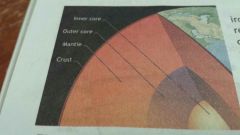
The core:
|

Core - beneath the mantle is the earth's core. The core is the innermost portion of the earth's interior. The temperature in the earth's core is very high. This layer ia dense and under great pressure. The core is divided into a fluid outer core and a solid inner core;
Outer core - • is about 2,500 km thick. • it is composed of iron-rich metal alloy. • this part of the core is liquid. • this core contains iron, which is in its liquid form, the material flows and swirls as tge earth rotates or spins in its axis. • the swirling of this material generates electricity that acts like an electromagnet, accounting for the formation of the earth's magnetic field. • the magnetic field is responsible for the functioning of the mechanical and bioligical compasses, and, at the same time, causes the slight jerking motion of the earth as it rotates. • Such slight jerking is one of the reasons for the delay in the period of rotation. Inner core - is the earth's innermost part. • it is about 1,200 km thick and is made up of solid iron and nickle. • the presence of iron and nickel makes the inner core the densest layer of the earth's interior. • temperature of the inner core may reach 5,000°C, which is hotter than the surface of the sun. |
|
|
Other topics:
|
Look at your book you *******! Don't be lazy for Pete's sake!
|

